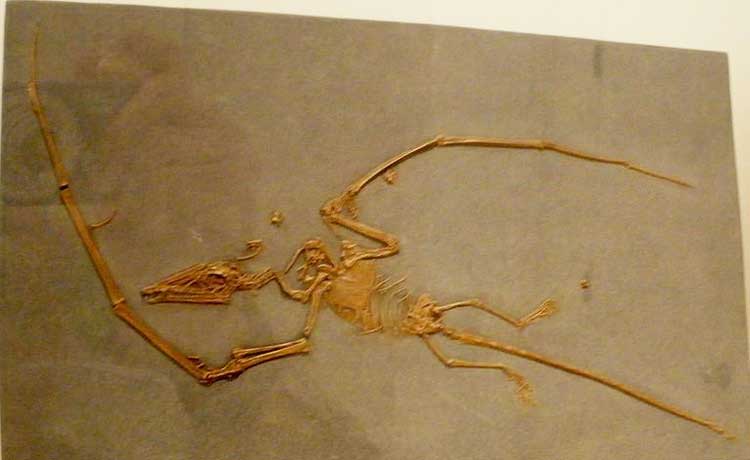Campylognathoides, American Museum of Natural History, New York (*)
Campylognathoides ("curved jaw", Strand 1928) was a genus of rhamphorhynchoid pterosaur, discovered in the Württemberg Lias deposits and was the first specimen from the area, consisting of wing fragments. Further better preserved specimens were found in the Holzmaden shale and it was based on these specimens that Felix Plieninger erected a new genus.[1] Anatomy and gait Compared to relative Dorygnathus, the snout on this genus is relatively short, but both genera had large eye sockets. The eyes of Campylognathoides have caused some researchers to suspect that it had acute vision, or possibly even a nocturnal lifestyle. Like its snout, the teeth of Campylognathoides were also shorter than those of Dorygnathus, as well as being conically shaped. They were not at all fang-like as in the markedly heterodont Dorygnathus. The snout ended in a point with the teeth being sparse and pointed and may have been a fish eater like its long-toothed relative. The sternum of Campylognathoides was a rectangular plate of bone with a forward facing crest called a cristopina.[1] A fossil collector found a well preserved Campylognathoides hip in a Braunschweig shale quarry in 1986. The hip proved scientifically significant because the hip socket was in an upward lateral position, preventing the animal from being able to orient its legs erectly like in dinosaurs, birds, and mammals. This proved that Campylognathoides wasn't able to walk on its hind legs but must have walked quadrupedally. This gait posture has been confirmed in other rhamphorhynchoids as well.[1] Classification and species The remains now known as Campylognathoides were first called Campylognathus (Pleininger 1895) until it was discovered that the name was preoccupied by a genus of the Hymenoptera. Three species of Campylognathoides are known: * Campylognathoides zitteli (Pleininger, 1894) is the type species. The larger Holzmaden Campylognathoides, C. zitteli had a 5 foot 8 inch (1.75 m) wingspan.[1] * Campylognathoides indicus (Jain, 1974) C. indicus was described by S. L. Jain on the basis of a fragment of jaw recovered from Chanda district, India.[1] * Campylognathoides liassicus (Quenstadt, 1858 [originally Pterodactylus liassicus]) C. liassicus had a 3 foot wingspan, making it smaller than its Holzmaden contemporary, C. zitteli.[1] See also * Dorygnathus References 1. ^ a b c d e f "Campylognathoides." In: Cranfield, Ingrid (ed.). The Illustrated Directory of Dinosaurs and Other Prehistoric Creatures. London: Salamander Books, Ltd. Pp. 292-295. * Dinosaurs and other Prehistoric Creatures, edited by Ingrid Cranfield, 2000 Salamander Books Ltd pg 285-286. External links
Retrieved from "http://en.wikipedia.org/" |
|

